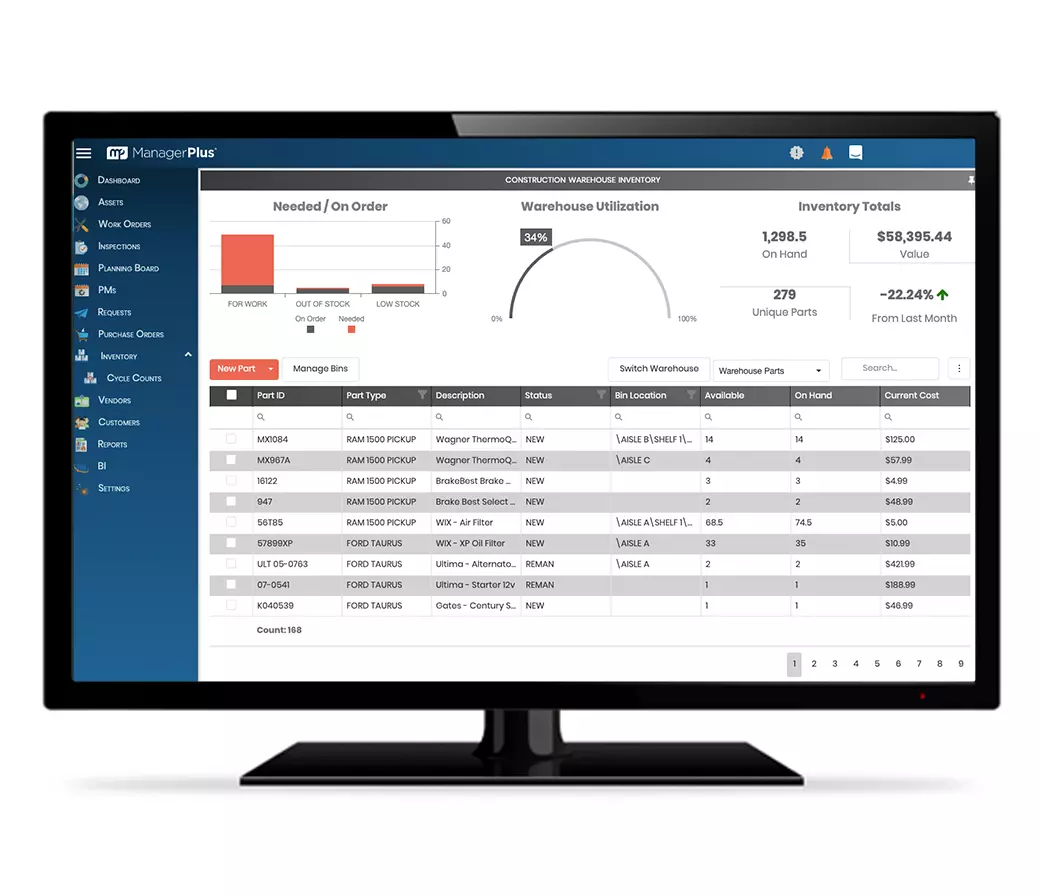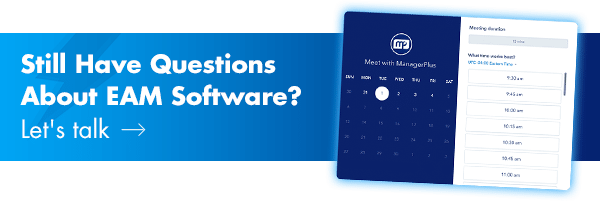What do monkeys and asset management have in common?
Hopefully, you aren’t ever using monkeys to perform maintenance on your assets, but the story of the Five Monkeys Experiment does offer several important lessons for asset management.
Especially when it comes to developing standard operating procedures for your operations.
What is an SOP?
A standard operating procedure (SOP) is a document designed to present a detailed method or procedure for accomplishing a specific task. Almost every business in every industry on the planet has SOPs for a range of tasks.
Generally, SOPs are created for tasks that are best done when following a set list of steps. Training and onboarding new people are one place that can benefit from good SOPs. Making sure every new person is trained the same way can avoid a lot of frustration down the road.
What’s the difference between SOPs and best practices?
Industry best practices are not the same thing as SOPs, and you should not rely on best practices in place of robust SOPs. While they do have some similarities, and your SOPs should certainly draw from best practices, they are not the same thing.
For instance, an industry best practice might be to perform a safety inspection on a piece of machinery after every 100 hours of use. The best practice may not specifically tell you how to perform the inspection, just how often it should be performed.
You would use the best practice as a base for creating your inspection schedule, and it should be included in your SOP, but it would not be a suitable replacement for a well-documented standard operating procedure.
What is the Five Monkeys Experiment and how does it relate to asset maintenance?
In the story of the Five Monkeys Experiment, a researcher places five monkeys in a cage with a bunch of bananas hanging from the ceiling by a string and a ladder leading up to the bananas. The first time a monkey starts climbing the ladder to get the bananas, the researcher sprays all the monkeys with cold water for several minutes.
Later, when another monkey goes for the bananas, the researcher sprays them all again. After the second time, the researcher puts the hose away and never sprays the monkeys again. When a third monkey makes an attempt for the bananas, out of fear of punishment, the other monkeys attack him and keep him from climbing the ladder.
The researcher then replaces one of the monkeys with a brand-new monkey who never received the punishment for attempting to get the bananas. However, as soon as the new monkey tries to get the bananas, the other monkeys attack him to keep him off the ladder. They continue to do this until the monkey learns not to try for the bananas.
Then, another monkey is replaced with a new monkey who was never hosed and when he tries to climb the ladder, the first new monkey who was never sprayed joins in the attack to keep the second new monkey from getting on the ladder.
Eventually, the researcher replaces all the monkeys in the cage to where none of them were ever sprayed with water, and yet, any time a new monkey tries to reach the bananas, all the other monkeys attack, even the ones who were never sprayed with water. At the end of the experiment, all of the monkeys learned to never go after the bananas, even if they were never punished for it.
The researcher’s hypothesis was that the monkeys attacked each other because that’s the way it was always done.
Sound familiar?
Far too often maintenance departments, in particular senior technicians, perform their tasks the same way every time simply because that’s the way they’ve always done it, even if there’s actually a better way.
To give an example of how doing something the same way it’s always been done may not be the most efficient, there’s a story of a woman who would cut about two inches off the end of a ham whenever she would cook it. When her husband asked her why did it that way, she replied, “That’s the way my mother did it.” When she asked her mother why she did it, she got the same answer: “That’s how my mother did it.” When they asked the grandmother why she would cut a good two inches off the ham before she cooked it, she laughed and replied, “Well, because the pan was too small!”
Developing and implementing robust SOPs helps you identify practices that may be inefficient and documents the best way to do it so critical tasks get done the right way, without wasting time and money.
Why are SOPs important in asset management?
One of the difficult challenges in maintenance and asset management operations is often getting your entire team on the same page and working together. Everyone is there to do their jobs, and while they do their jobs well, all too often maintenance techs can fall into the rhythm of just punching the clock day in and day out.
When that happens, it’s quite easy to get into the habit of simply doing the same things the exact same way every day, simply because that’s what’s worked before so why fix what isn’t broken?
The problem is that as technology improves and industry best practices change, we often find better, more efficient ways of accomplishing tasks. Without concise directions and procedures, particularly around repetitive tasks such as preventive maintenance, everyone on your team can quickly sink into their own way of going things and soon you’ll have a group of techs trying to keep things running instead of a well-oiled maintenance machine that works together to eliminate unplanned downtime.

This is where standard operating procedures (SOPs) can have a big impact on your operations. SOPs are clearly defined and documented ways of accomplishing tasks and are essential to standardizing information and processes across your organization. They are the best way to make sure that when it comes to the most important tasks related to your assets, everyone is on the same page.
Clear, well-defined, and documented SOPs help you:
- Adhere to industry best practices
- Maintain consistency
- Streamline tasks
- Ensure proper training
- Retain expert knowledge
Align your operations with industry best practices
As we mentioned earlier, your SOPs should certainly include industry best practices and when they are included, following them is no longer merely suggested or recommended but a clearly documented requirement.
Creating an SOP backed up with industry best practices no longer simply gives your team a goal to aim for but provides them a clear guide on how to get there. Good SOPs that are clearly written and well-defined help your team accomplish tasks more efficiently, which saves you time and money.
Keep your operations consistent
One of the easiest ways to waste time and resources is by having inconsistent processes for your maintenance operations. If everyone performs the same inspections and repairs in different ways, you’ll get a different result every time.
When everyone knows what to do and how to do it and can follow a clear list of steps to get there, you can guarantee the same results.
This is also important because it helps you track down problems more quickly and keep technicians accountable. If there’s a problem with a piece of equipment, and you discover that the last tech who worked on it didn’t follow the SOP, you can quickly fix the problem and provide additional training to the tech who needs it.

Help your team work more efficiently
As we saw above, just because doing something the same way every time gets the job done, doesn’t necessarily mean it’s the best way to do it. A large part of developing SOPs is finding industry best practices, speaking with senior technicians, and reference manuals and OEM documentation to make sure you’re working as efficiently and effectively as possible.
Then, once you’ve established the best way to do things, the SOP helps to make sure that everyone on your team does the job the best way possible, every time.
The efficiencies of SOPs extend beyond the physical maintenance tasks. When you have a consistent, repeatable method for getting work done, it also helps you maintain the right inventory. If you have one tech who uses glue to fix something and another one who uses duct tape instead, when you standardize the process, you don’t have to keep stocking both glue and duct tape.
Better, more standardized processes will also help your techs work faster. There’s a reason professional athletes are so good at what they do. They practice, over and over again. They work hard to find the best way to do something, then they do it, repeatedly, until they excel at it. Michael Jordan famously shot 1,000 free throws a day during his career, and it paid off.
Once you establish the most efficient method for doing things, and your techs continue to perform that task the same way, they will be able to do it faster which frees them up to work through your backlog.
Make sure everyone is trained correctly the first time
Have you ever trained someone new in how your organization does things, only to find another tech showed them a “better way” to do it and now things aren’t getting done correctly? When you have good SOPs at your organization, any new person you hire at the company will know how to do the job correctly from day one, and you can make sure they do it the right way every time.
Don’t lose expert knowledge when techs move on
Your senior techs have some of the most valuable knowledge in your organization. They’ve been operating and repairing your assets for years and they know the ins and outs of what makes them tick. But what happens when they leave? If they retire or move on to another company, does that invaluable knowledge go with them?

SOPs are one sure-fire way to avoid that. When you have clearly documented SOPs that you’ve developed along with these seniors techs to get their feedback and input, you have that knowledge stored at your organization forever. You no longer have to worry about that one “equipment whisperer” not being around if a critical asset goes down. Anyone on your team will have the knowledge they need to bring it back online fast.
What do I need to know before I write my SOP?
Before you begin writing your SOPs, are three main things to consider:
- Consider the purpose
- Consider the procedure
- Consider the audience
Know why you’re writing the SOP
Before you undertake any action, it’s a good idea to think about the goal you’re trying to accomplish. What is the reason for this SOP? Are you trying to achieve more consistent results from your PMs? Are you hoping to increase your equipment uptime by standardizing your repairs? Do you want to improve safety at your organization?
No matter what you’re trying to accomplish, you need to have a clear purpose for building the SOP before you even start, or you won’t get the results you want.
Know which procedures need SOPs
Not every task your team will undertake will need a detailed list of steps to make sure it gets done right. For example, changing a light bulb. There are best practices to keep in mind like wearing eye protection and having someone to spot you if you need a ladder, but your team should not need an entire SOP to know how to change a light bulb properly.
There are other processes where a standardized list of steps ensures you always get the desired result. In general, SOPs work better for routine or repetitive tasks. Things like routine inspections, PMs, inventory cycle counts, etc. are all things that SOPs are great for. They are routine, repetitive tasks that need to happen the same way every time to be the most efficient.
Things that SOPs wouldn’t be good for are more complex decision-making tasks or things that require creative problem solving to find a solution. For example, when deciding whether it’s time to continue repairing an asset or if it’s time to replace it, an SOP may not be that helpful.
Know the audience that will be reading the SOP
Any time you’re writing something that someone else will be reading, it’s important to know your audience. It doesn’t do any good to take the time and effort to explain how to lubricate the gears on a conveyor belt for the marketing department.
When preparing to write your SOPs, think about things like the technical skills of the people you’re writing for. Is this something that’s for the more senior techs who already have a strong set of skills, or is the for the junior techs who need a little more direct?
It’s also good to consider if there are any current practices that you’re looking to correct or enhance with this particular SOP. It might be good to explain why a certain task needs to be performed differently than the way it’s currently being done to help everyone get on the same page with the new SOP.
Lastly, you want to make sure the SOP has the correct scope. For instance, is the SOP covering a very specific task within one department that is performed by one or two people? Or is it something for the entire department or even multiple departments to be aware of? Not having the correct scope in mind for your SOP can lead to a lot of confusion down the road.
How do I write an SOP?
To begin developing your SOP, after you’ve established the goal you’re trying to accomplish, the procedure you’re writing it for, and the audience who’s reading it, there are some good steps to follow.
1. Get input from your technicians
Your technicians are the ones who know you’re assets best and are the best resource to ask when determining what steps need to be included in your SOP. This not only gives advice and suggestions straight from the experts, but it gets your team involved in the process which is sure to increase their buy-in. Getting your techs bought into the new SOPs is the best way to make sure they adhere to them.
When they’re involved in the process, they have more ownership over the outcomes and are more likely to follow them and make sure any new members of the team follow the SOPs as well.
2. List the necessary components for the task
Every task requires resources to get it done. Whether it’s changing a light bulb or locking out a machine at the end of a shift, everything needs resources of some kind.
For your SOP, make sure you’ve talked to your technicians, so you know exactly what’s needed to complete the task, then list them out in the SOP. If they need a number 6 torque screw, make sure to list that. Be sure to include any PPE they need as well.
Tasks require more than just equipment to get them done. You also need people. Be sure to list out how many people are needed for the task and if any special skills are required. For example, does the task require the use of a forklift? If so, you’ll need to make sure that someone involved in the task is certified to operate the forklift. It’s a good idea to include any relevant manuals or technical documents as well so your techs have all the information they need.
Whoever is performing the task also needs to know what parts and materials may be required. If you’re using inventory management software, you automatically assign the necessary parts and materials to any work order generated based on this SOP. And if you’re using work order management software, you can schedule these work orders to be generated, with the included inventory list, for any of these regularly scheduled tasks.

Lastly, make sure to list any specific safety concerns in the SOP as well. If there are any safety regulations or standards that pertain to the task, be sure to list those as well. A common example is lifting a box. If one of the steps in the SOP requires the technician to lift something heavy, be sure to note the correct way to lift the object to avoid getting hurt or injured.
3. Write in the appropriate format
For SOPs, there are three main formats to structure them in.
Step-by-step – this method is for the most standard and simple tasks and is a simple list of steps required to perform the action. This might be something like setting up tools or equipment or locking down and tagging out equipment at the end of a shift. The steps are simple and easy to follow and don’t require much explanation.
Hierarchical – this method is a step beyond the straight linear approach of the step-by-step method. A hierarchical SOP is used when certain steps of the process require more explanation. A good example might be an inspection of a complex piece of equipment. Instead of just listing, “Inspect machine arm” you might need to list the specifics of how to do that.
Flowchart – flowcharts are used when there might be multiple outcomes from performing a certain function and each step in the process might impact how the next steps will need to be approached. For example, when troubleshooting a piece of equipment, you might need to perform Step A, then depending on the outcome of that task, perform Task 1 or Task 2. If Step A is to power on the machine, then the workflow might be that if it turns on, Task 1 would be to proceed to Step B. If the machine does not power on, then Task 2 might move the technician further down the path of repairing the machine.
4. Write the procedure
When writing out the steps of the task in your SOP, you need to make sure it is clear and concise. Make sure you include enough detail, but don’t overcomplicate things. Write out each step as clearly as possible to make sure it can be followed accurately.
Keep it brief and to the point. There’s no need for long, drawn-out, rambling instructions that could lead to a miscommunication or misunderstanding. If your techs are constantly having to track you down for clarification on an SOP, you’re wasting time and resources and defeating the entire purpose of having SOPs in the first place.
Make sure your SOPs are easy to understand. This goes back to knowing your audience. If the SOP is for your more senior techs, they’ll be able to understand things differently than someone with less experience and might get confused if you try to explain too much. The same works the other way. Your junior techs might not understand highly technical jargon so write it in a way that they’ll understand.
5. Review the SOP with your team
This is arguably the most important step in the entire process. If you just write an SOP and throw it out to your team without having anyone look at it, you might have completely missed the point of the document and added a whole lot of extra confusion and frustration.
After the SOP document is completed, you want to have as many people look at it as possible. Your supervisor or department head can make sure it’s in line with the company’s goals and your technicians can make sure it’s easy to understand and follow, and that it’s not missing anything critical.
The goal of any SOP is to make a task or workflow consistent and concise, so you need to make sure everyone who uses it, understands what it’s saying. It’s important to have your junior techs look at it as they might ask questions that you didn’t think about which they need to know.

6. Train your staff
No matter how great your SOP is, if you’re team doesn’t use it, it’s worthless. Once you’ve developed and reviewed the SOP, you need to train your team on it.
The first part of training is to make sure your team has access to the SOPs whenever they need to refer back to them for any reason. The best place to store your SOPs so your team can get to them easily is in your enterprise asset management (EAM) software.
Training can sometimes be a sensitive topic, especially for more senior techs who’ve been around a lot longer and are used to doing things a certain way. This is another reason why getting their input during the development is so critical. If they were part of building and developing the SOP, they’re much more likely to support it and encourage the rest of the team to adhere to it.
As part of the training, make sure to explain the goal behind the SOP to help everyone understand that there is a reason for it that is beneficial to the whole company.
7. Implement, monitor, and update regularly
Now that your SOP is complete, it’s time to implement it for your team. Again, getting buy-in is critical here as it will make the implementation process a lot smoother. Work with your team to make sure that everyone understands the document and the expected outcomes.
As we discovered with the Five Monkeys Experiment, doing something the same way just because that’s the way it’s always been done is rarely the most efficient way of doing things. Technology improves, recommended best practices change, and smart people who are empowered to think creatively, will always find better ways of doing things.
Because of this, be prepared to regularly revisit and update your SOPs if necessary. Developing and implementing standard operating procedures is never a “one and done” process. Your goal should always be to make sure that whatever processes you have in place are the safest and most effective way to get things done.
What’s the best way to give my team easy access to SOPs?
Standard operating procedures are incredibly useful for helping your asset management and maintenance teams become more effective at what they do which saves you money and helps you get more ROI from your assets.
EAM software helps you keep your team on track with your SOPs by allowing you to attach them to relevant work orders automatically so anyone who’s performing the task has the SOP readily available. With cloud-based EAMs like ManagerPlus, your techs can access their work orders, and any other relevant information, from any internet-connected device, so no matter where they are, they have everything they need right at their fingertips.
With EAM software, you can take the process one step further by scheduling your PMs on the calendar and when it’s time to do the job, a work order will automatically generate, with the relevant SOP already attached, and be assigned to the right technician.
The cloud-based nature of EAM software means that every step of your work orders, and the SOPs, can be tracked so you can follow up with your team and see how effective your SOPs are. All the relevant parts and materials assigned to the work orders are also allocated automatically and your stock levels are instantly updated when there’s a change, so everyone’s always working from the same accurate source of information.
Executive Summary
Developing standard operating procedures (SOPs) for your organization is all about working with your teams to discover the safest and most efficient way of performing tasks, then clearly and concisely documenting the process to ensure you consistently get the desired results. SOPs are best suited for routine, repetitive tasks where you want to guarantee an outcome every time the task is performed.
Clear, well-defined, and documented SOPs help you:
- Adhere to industry best practices
- Maintain consistency
- Streamline tasks
- Ensure proper training
- Retain expert knowledge
While developing SOPs takes time and resources, the benefits are almost always worth the costs, especially if you adopt EAM software at your company to implement, track, and improve your SOPs across your organization.
Next steps
The right tool can make all the difference when undertaking a challenging task. ManagerPlus can help you develop and implement strong SOPs at your organization and the best way to get started with ManagerPlus is to see it in action for yourself. Schedule a personalized, one-on-one demo with one of our experts so you can see firsthand how you can streamline your workflows and ask questions about how to overcome your operational challenges.


